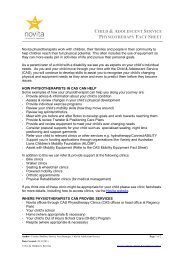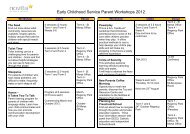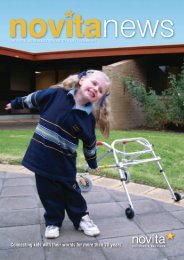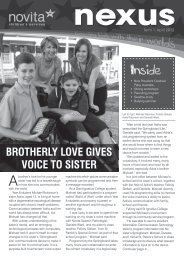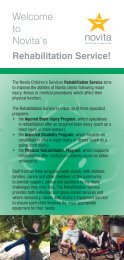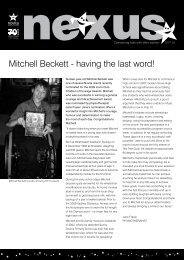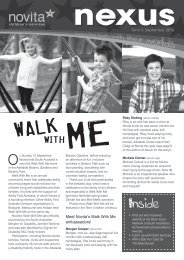Novita Research Report - 2004 to 2007 - Novita Children's Services
Novita Research Report - 2004 to 2007 - Novita Children's Services
Novita Research Report - 2004 to 2007 - Novita Children's Services
- No tags were found...
You also want an ePaper? Increase the reach of your titles
YUMPU automatically turns print PDFs into web optimized ePapers that Google loves.
22Project titleContribu<strong>to</strong>rsFundingSummaryThe relationship between ankle-foot-orthosis (AFO) shank vertical angle and optimalgait in children with cerebral palsyEmily Graham, Susan Gibson, Tam Nguyen (Repatriation General Hospital, Adelaide), DrPaul Grimshaw (University of South Australia), Dr Lloyd Walker• Channel 7 Children’s <strong>Research</strong> FoundationMany children with cerebral palsy (CP) wear an ankle-foot-orthosis (AFO), sometimes calleda splint, <strong>to</strong> help control abnormal ankle movements. One type of AFO that may be requiredis the solid AFO, which are made individually for each child out of rigid thermoplastic. SolidAFOs can be made so that the calf section (or shank) is vertical or tilts either forward orbackward from vertical. Making small changes <strong>to</strong> this angle by placing wedges of materialbetween the heel of the AFO and the shoe is called ‘tuning’, and is described as changingthe shank vertical angle (SVA). Tuning affects how the child walks and is an important part ofprescribing and fitting a solid AFO – however very little research has considered how tuningsolid AFOs affects walking in children with CP and how it may affect their functional ability.Recent research based on clinical experience in the United Kingdom has suggested thattilting a solid AFO forward by approximately 10-15 degrees improves walking, balance andenergy efficiency and can help result in a more normal walking pattern. However this hasnot been quantified by measuring the kinematic and kinetic effects on the body or the effec<strong>to</strong>n the child’s upright functional ability. Therefore this study aims <strong>to</strong> determine the effect ofdifferent AFO SVAs on the walking of children with CP. This study also aims <strong>to</strong> investigate theeffect of a permanent change <strong>to</strong> the tuned angle on the child’s functional ability.MethodChildren diagnosed with diplegic or hemiplegic spastic CP, who wear solid AFOs and who donot walk with any assistance, were invited <strong>to</strong> participate. After being fitted with new AFOs, thechildren underwent three functional tests <strong>to</strong> measure their walking endurance, walking speed,functional mobility and balance. Parents participated in a short interview <strong>to</strong> determine theirperception of their child’s performance in achieving set outcomes and goals.The children then under<strong>to</strong>ok a gait analysis session at the Motion Analysis Labora<strong>to</strong>ry at TheRepatriation General Hospital, walking barefoot and in their AFOs while they were set at threedifferent angles – five degrees, 10 degrees and 15 degrees forward tilt. The movement oftheir limbs and <strong>to</strong>rso was recorded using three dimensional VICON motion capture. This datais analysed by the research team <strong>to</strong> determine which angle produced the most normalisedwalking pattern for that child before wedging the AFOs <strong>to</strong> this angle. After four months ofwear, the children will complete follow-up functional tests <strong>to</strong> detect whether there were anychanges after altering the tilt of the AFOs.ResultsImplicationsSix children have been recruited and undergone the first functional tests and gait analysissession. The final stages of data collection for this project will be completed in early 2008.For clients – if results from this study support our hypotheses, the ‘tuned’ AFOs will improvechildren’s walking pattern and also potentially their functional mobility, balance, enduranceand walking speed, compared with traditional AFOs.For services – this study will expand the AFO prescription options and help define the clientcharacteristics that indicate the use of ‘tuned’ AFOs.StatusOngoing




